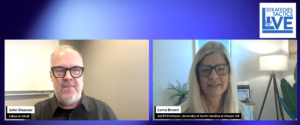
Plus: Pinterest positions itself as a positive social network; Amazon Web Services explains massive outages.
Sometimes, the best way to tell a story is from the inside out.
Increasingly, employees are becoming popular faces on brand social media accounts. The New York Times highlighted a variety of businesses putting employees in front of the camera, from Delta aviation technicians to Lego designers. Quick service food chain Portillo’s even hopes to have at least one “internal influencer” working at every store.
At some companies, including Portillo’s and DHL, employees aren’t just featured on brand accounts, but are also encouraged to highlight their day at work on their personal accounts. DHL encourages couriers to film their routes and use a hashtag to flag their posts for potential amplification.
The upsides are clear: Real people telling stories in a way that avoids the too-careful, too-scripted nature of many corporate social media accounts. But the downsides are also obvious: Unenthusiastic employees, boring prompts or, worse, people displaying behavior that puts the brand in a negative light.
But it’s worth noting all that can happen – and may be more likely to happen – without a formal internal influencer program. With a program in place, there is some measure of training, standards and policies in place to encourage good behavior and caution against content that places the brand in a negative light.
Why it matters: It’s a cliché, but it’s still true: People trust people. And employees who perform these jobs day in and day out have the real stories, expertise and insight to make content stand out.
Even if your organization isn’t quite ready to encourage employees to post on their personal accounts about work, it’s still worthwhile to identify a group of workers with winning personalities, interesting jobs and some camera skills to take footage for you to then process and post on your brand pages.
And remember: This kind of work is work. Offering these employee influencers a bonus, a pay bump, extra PTO or other perks is a kind gesture that will make others more likely to volunteer.
Editor’s Top Reads:
- Pinterest is often seen as a forgotten social network, not usually mentioned in the same breath as Instagram, TikTok and X. But unlike many of its rivals, Pinterest is growing with a coveted audience: Gen Z. Half of the platform’s users now stem from this demographic, and Pinterest has transformed itself into a vibrant ecommerce platform, with the ability to purchase goods directly from the colorful pin boards. CEO Bill Ready attributes Pinterest’s success to its efforts to make the social network a “positive” place to be. Gen Z sees Pinterest “as a safe space away from the toxicity they experience elsewhere,” Ready told the Times. That extends into how Pinterest handles AI and how it protects brands – a sharp departure from other platforms. This story has two key takeaways: First, Pinterest may be worth a deeper look, if you haven’t already given it one. And second, there is a place for positivity on social media. As Ready put it, “So much of social media has become engagement via enragement.” But it doesn’t have to be that way. Through brands’ actions and their choice of platforms, things can change – slowly, but surely.
- Amazon Web Services released a detailed postmortem of the issue that took down large swaths of the internet last week. The release is largely for technical professionals, containing complex details such as, “In addition to providing a public regional endpoint, this automation maintains additional DNS endpoints for several dynamic DynamoDB variants including a FIPS compliant endpoint, an IPv6 endpoint, and account-specific endpoints.” Please don’t ask us what that means, we have no idea. While this level of detail is laudable and hopefully helps more tech-minded folks understand and take steps to prevent this from happening again, a version translated into laymen’s terms may have helped calmed the nerves of a public that feels jittery, having seen so much of the internet vanish due to one service. In the absence of that plain speech, the job of translating falls to the media translate using outside experts, such as in this CNN story. That isn’t necessarily a bad thing, but it does cede the narrative to an outside party, since a consumer-focused publication is unlikely to publish technical jargon. By offering both a techie and a normie version, AWS could have more tightly managed the post-event narrative.
- On Nov. 1, 40 million Americans will miss out on receiving their SNAP, also known as food stamp, benefits. This could have far-reaching effects for companies, ranging from those that sell food to the public, nonprofits that deal with food insecurity and companies where workers rely on SNAP to make ends meet. All these impacted organizations would do well to help point affected people toward food resources in their community and consider what they can do to help in the problem. Does that mean a food drive at work, a gift card for employees in need or a public facing statement? It will vary depending on your exact organization. But this is a vulnerable moment for many Americans – be ready to help meet it.
Allison Carter is editorial director of PR Daily and Ragan.com. Follow her on LinkedIn.
The post The Scoop: Employees are the new influencers appeared first on PR Daily.













![6 Tools to Find New Keywords [Free + Paid Options]](https://mgrowtech.com/wp-content/uploads/2025/08/find-new-keywords-sm-120x86.png)
